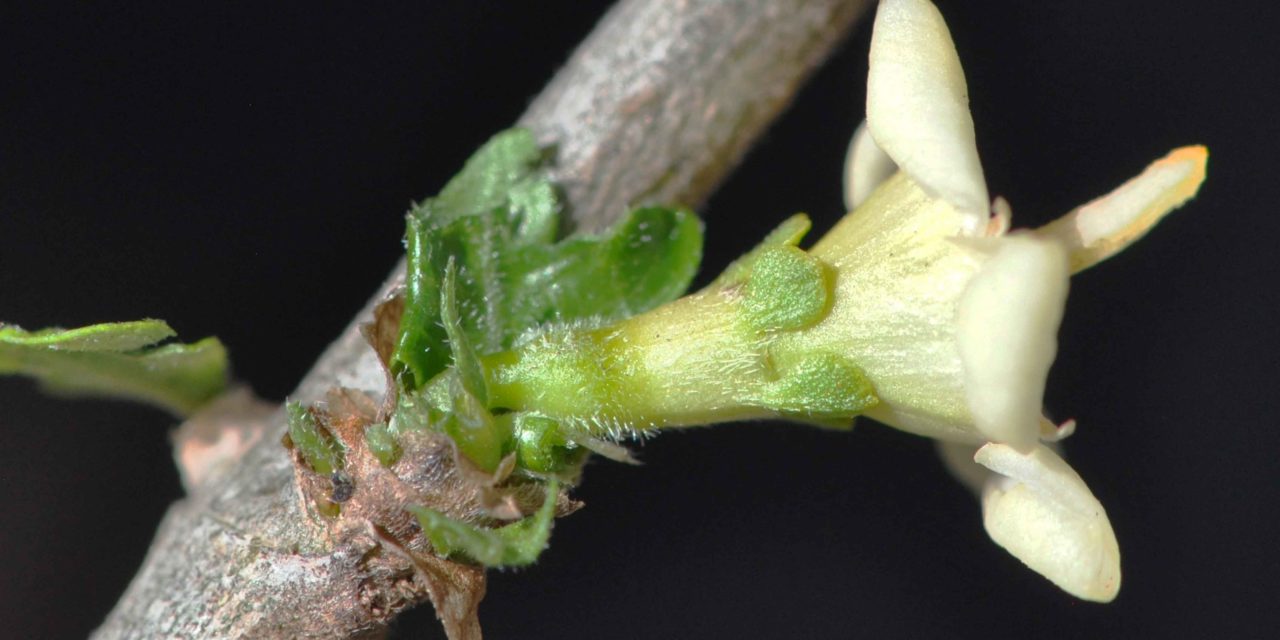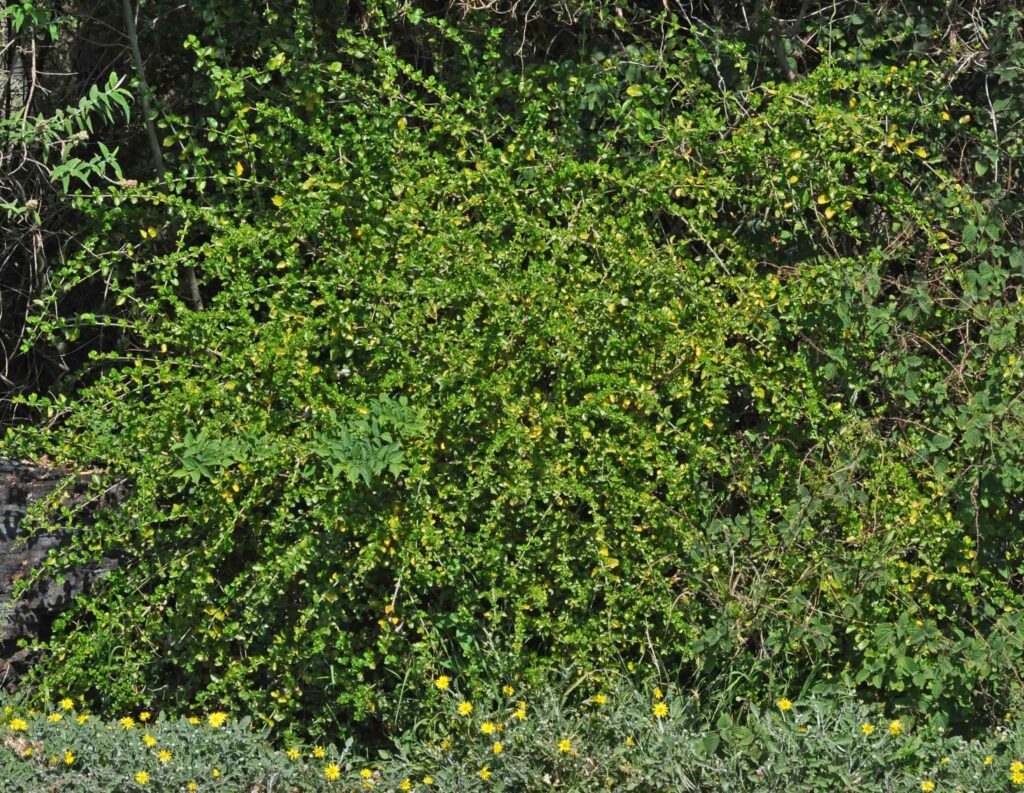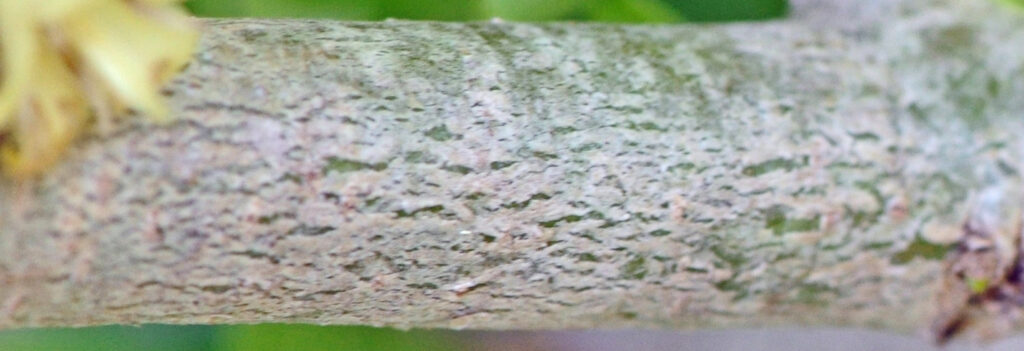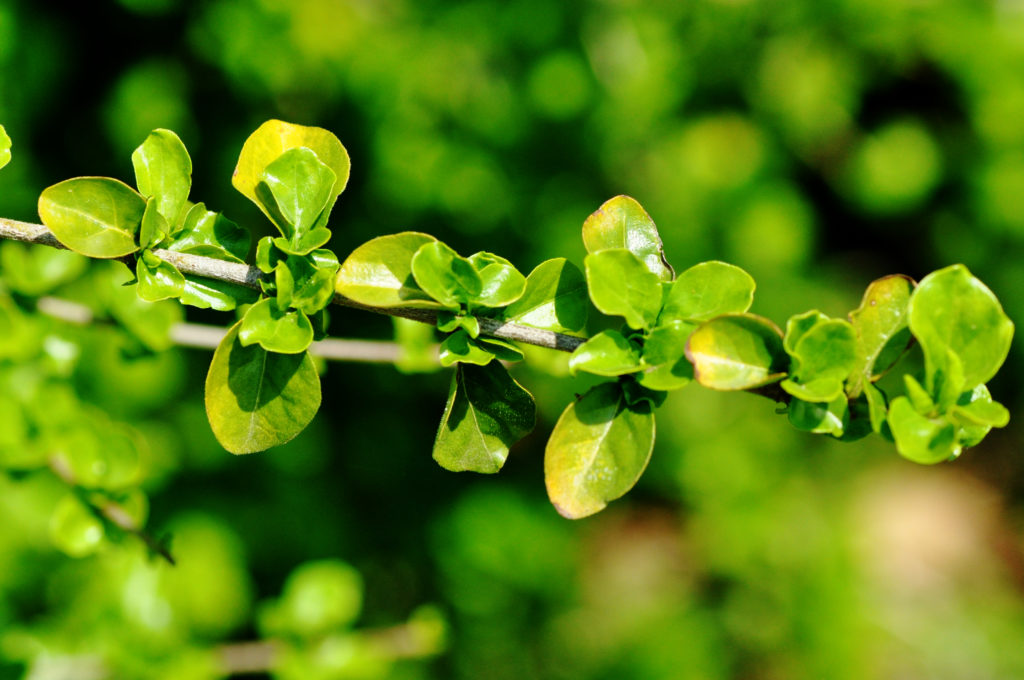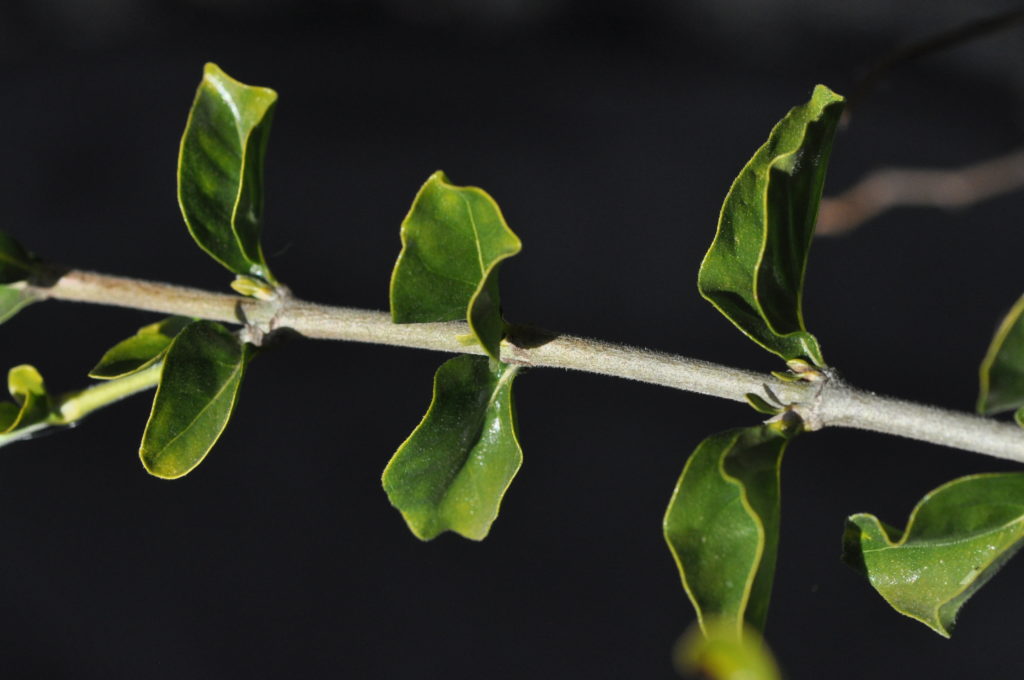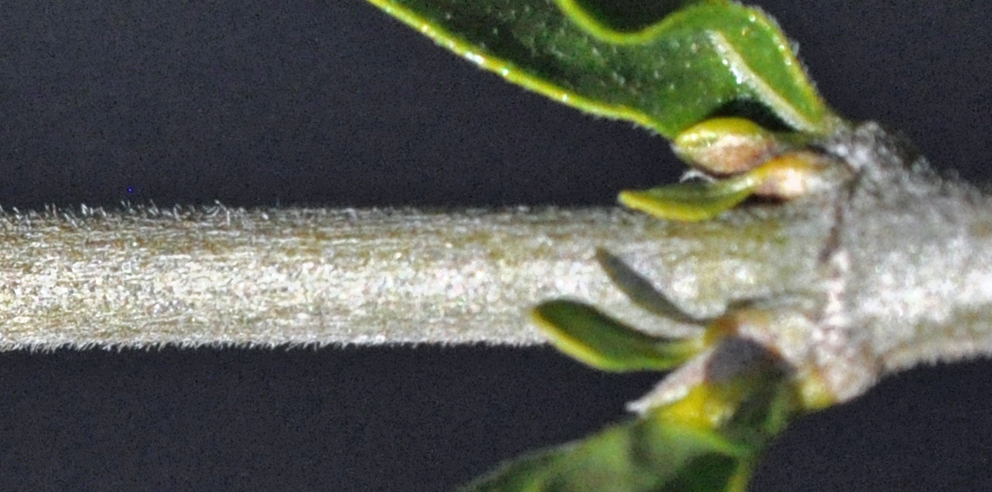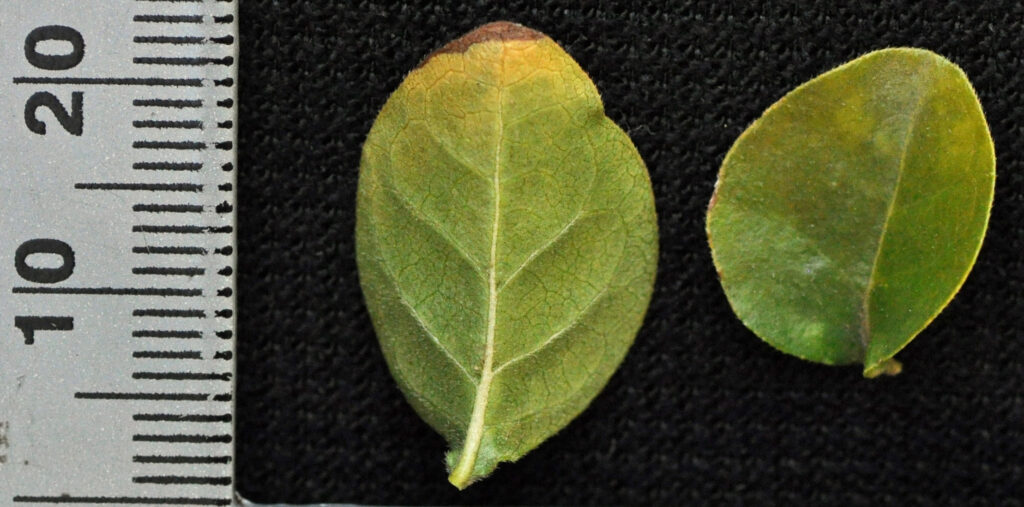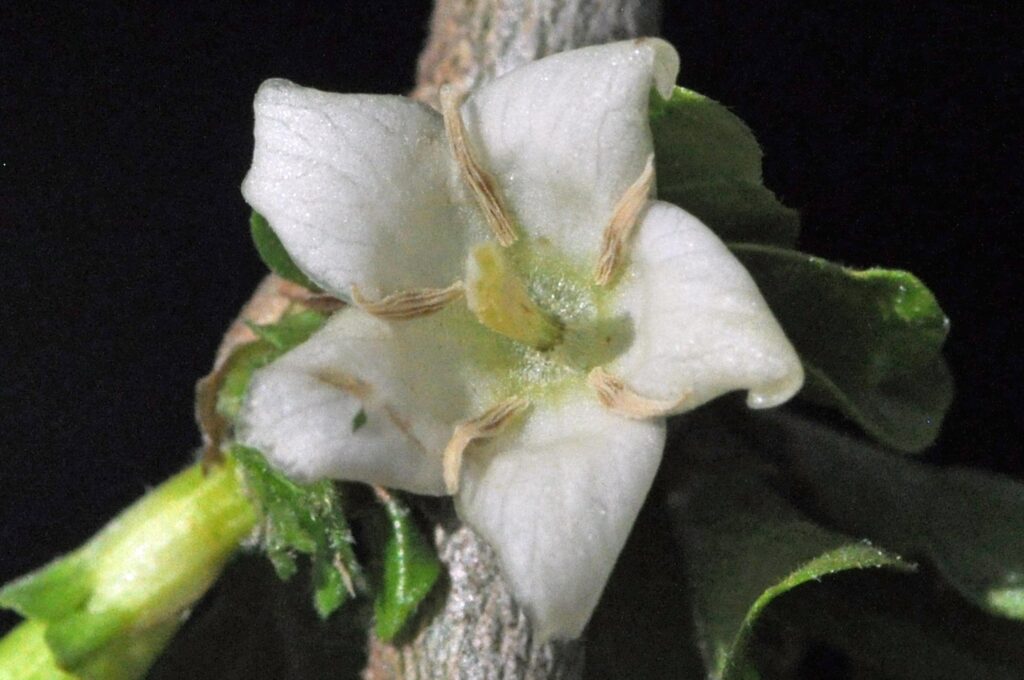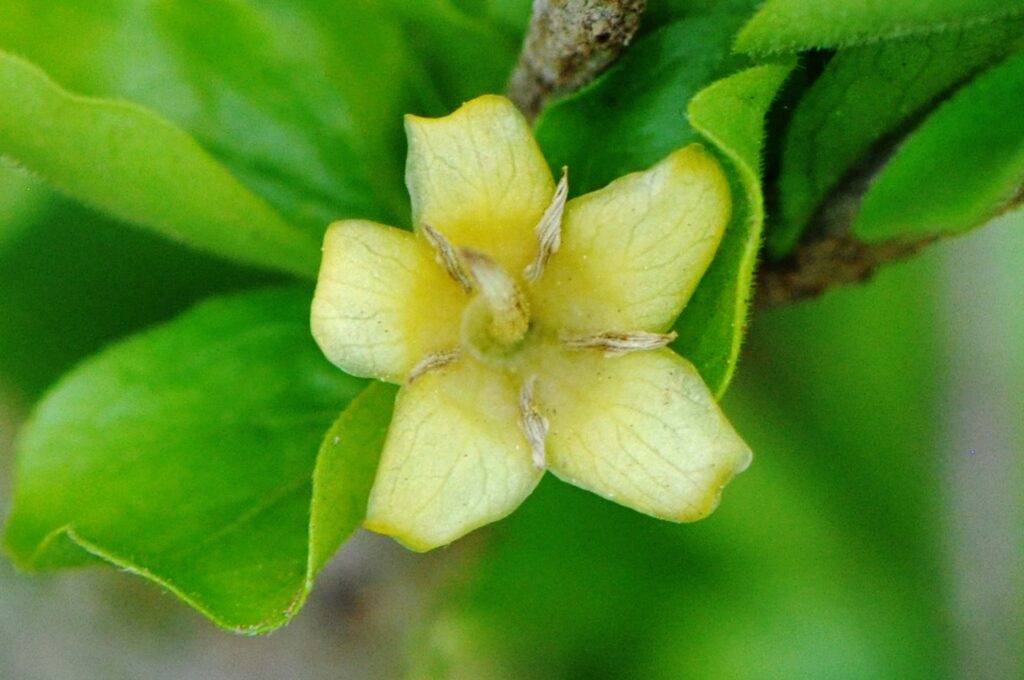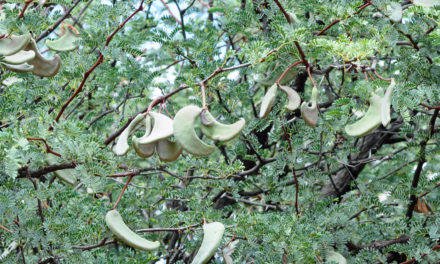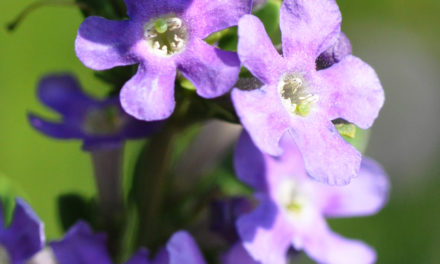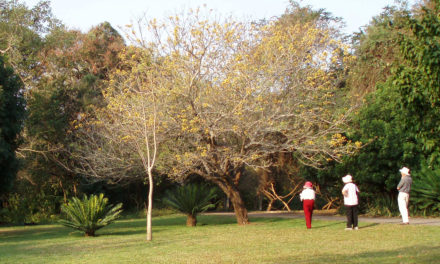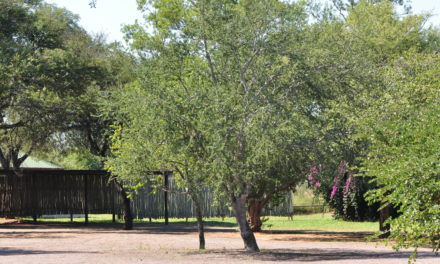Coddia rudis
General Info – summary
This Tree with smooth bark is up to 3m high and is usually a multi-stemmed shrub. Small, opposite, simple shiny, decurrent and roundish Leaves are entire with interpetiolar stipules. The regular, white 5-merous and actinomorphic Flowers have 5 long sessile anthers. The inferior ovary has a wide protruding style. The small, 2-locular, indehiscent Fruit has a persistent calyx. Seeds are hard, black and compressed.
Description
Previous Names: Lachnosiphonium obovatum, Lachnosiphonium rude, Randia kraussii, Randia lachnosiphonium, Randia rudis, Randia parvifolia, Randia vestita, Xeromphis obovate, Xeromphis rudis.
SA Tree No. 689.1
Common names: (Afr) Kleinbeenappel. (Eng) Lesser Xeromphis, Small bone-apple, Woodland xeromphis. (isiXhosa) Intsinda, Umgxube. (isiZulu) Isikwakwane, Umdondwani, Umgogwane-omncane. (siSwati) Sikhwakhwane. (Tshivenda) Mukwakwa, Mulivhadze-tshitangu, Tshinapanapana. (Xitsonga) Sitole.
Family: Rubiaceae (Coffee/Gardenia family). This family of dicotyledonous plants has in excess of 600 genera and about 13 000 species and members include trees, shrubs and herbs. The plants are terrestrial and predominantly woody and sometimes Scandent (climbing without the aid of tendrils). Local genera with trees on this website include Afrocanthium, Canthium, Coddia, Gardenia, Pavetta, Rothmannia and Vangueria. Leaves are simple, opposite or whorled and have interpetiolar stipules. 4 or 5 merous usually regular Flowers are bisexual or unisexual. The calyx has sepals that are at least partly united. Petals are joined – at least at the base. Stamens are usually as many as and alternating with corolla lobes. The Ovary is inferior. Fruit is a drupe, berry or capsule.
Name derivation: Coddia named after the South African borne Leslie Edward Wostall Codd (1908-1999) who was the director of the Pretoria Botanical Institute from 1963-1973. In 1951 he produced the book: Trees and Shrubs of the Kruger National Park. rudis – rough, coarse or rustic. In southern Africa Coddia rudis is the only species of this genus.
Conservation: National Status: L C. Least Concern. Assessment: 2005 (W. Foden and L. Potter).
Tree
This tropical species is a small Tree that may reach 3m+ in height. However, it is usually a dense multi-stemmed shrub (photo 647) with irregular wide arching, hairy branches (photo 67 – under Leaves). The Bark is smooth, mottled light grey to brown (photo 848) and may be banded with pale brown or white. Browsing may cause this plant to become a compact shrub.
- 647. 2019/09/18. Walter Sisulu NBG. Photo: David Becking.
- 848. 2015/09/29. Walter Sisulu NBG. Photo: David Becking.
Leaves
This briefly deciduous tree has small, usually obovate (egg-shaped – with the narrower end at the base) or almost circular small Leaves that are up to 3 x 2cm (photo 836). They are usually hairless, simple (has a single blade, which may have incisions that are not deep enough to divide the blade into leaflets) and opposite (photo 67). Leaves may also be densely clustered on dwarf side shoots with abbreviated branches forming spines along the stems. The Blade is shiny, mid to dark green above but lighter below. The 3-5 pairs of lateral Veins are raised and visible below (photo 836). On the upper side, the midrib is slightly visible. Domatia (a tiny chamber produced by plants that house arthropods – to the naked eye the domatia appear as small bumps) are present in vein axils (photo 836). The Apex is very broadly tapering to rounded (photo 655) and occasionally notched. The Base is narrowly to broadly tapering and decurrent (here the leaf blade partly wraps or have wings around the stem or Petiole – leaf stalk – photo 836). The wavy Margin (photo 67) is entire (continuous, not in any way indented). The petiole is short: 1-3mm long. Stipules (basal appendages of the petiole) are interpetiolar (between the petioles), up to 2mm long and fall early. Stipule remains are visible and appear like a line between pairs of leaf petioles (photo 67E).
- 655 2015.09.22 Walter Sisulu NBG. Photo: David Becking.
- 67. 2016/06/21. Walter Sisulu NBG. Photo: David Becking.
- 67E. 2016/06/21. Walter Sisulu NBG. Photo: David Becking.
- 836. 2015/09/29. Walter Sisulu NBG. Photo: David Becking.
Flowers
Up to 3 fragrant, bisexual, gardenia-like Flowers are borne in leaf axils. Each individual flower is up to 1,5cm wide, 3cm long and rests on a short (up to 2mm long) pedicel (stalk of a single flower). They appear at about the same time as the new leaves. The initially white flowers (photo 648) age to a yellow colour (photo 847). Flowers are actinomorphic (Regular, symmetrical. Flowers are vertically divisible into similar halves by more than 1 plane passing through the axis). The Calyx has 5 Sepals which have a hairy, cone-shaped base ending in short green lobes which reach about one third the length of the petals (intro photo). The Corolla has petals with a cylindrical base and a funnel shaped upper part that is initially white or creamy coloured (intro photo). With time, it turns dark yellow (photo 847). Extending horizontally from the funnel shape are 5 slender Petal lobes which are shorter than the tube. These lobes become recurved (intro photo). The 5 Stamens are attached within the corolla tube and the long, linear anthers protrude just above and between the bases of the corolla lobes (photo 648). This photo shows the hairy light green lower part of the visible petals. The long sessile Anthers are apiculate (ending in a short, sharp, flexible point – photo 847) and have 2 pollen sacs which partly emerge between the petal lobes and dehisce through longitudinal slits. The 2-locular (chambered) inferior Ovary has a whitish, broad, protruding Style (intro photo) which is narrowly club shaped and slightly winged at the apex. (Aug–Nov).
- 648 2019.09.18 Walter Sisulu NBG. Photo: David Becking.
- 847. 2015/09/29. Walter Sisulu NBG. Photo: David Becking.
Fruit
The indehiscent, 2-locular (2 chambered) Fruit is greenish-brown and almost spherical to ellipsoidal. It is up to 11 x 6mm and crowned with persistent Calyx lobes. Dry fruits are brown or black and very hard. Pale chestnut-coloured and ovoid-angular Seeds are compressed and initially imbedded in pulp. (Jan–Jun).
Distribution & Ecology
This plant is endemic (Endemism is the ecological state of a species being unique to a defined geographic location) in southern Africa. It occurs in the Eastern Cape, KwaZulu-Natal, Mpumalanga and Limpopo. Beyond South Africa, plants occur naturally in Zimbabwe, southern and central Mozambique, and in Eswatini (Swaziland). Plants are found in moist bushveld, woodland, forest margins, rocky areas and scrub, both inland and at the coast. They are common on rocky outcrops and usually found below 1 500m. Herbivores including rhino, Nyala and Kudu browse the Leaves and Stems. Impala consume the Leaves.
Ethnobotany
Fruit is edible. The yellowish-red, heavy, dense and compact Wood is too small to be of much use to man. Domestic stock graze the Leaves. It is used for bonsai, and easily Grown from seeds. This plant is quite fast growing. It is drought and wind resistant and can survive reasonably high temperatures. It grows from Seed and makes a good container plant. Local medicine makes use of this plant.
References
Boon, R. 2010. Pooley’s Trees of eastern South Africa. Flora and Fauna Publications Trust, Durban.
Burrows, J.E., Burrows, S.M., Lotter, M.C. & Schmidt, E. 2018. Trees and Shrubs Mozambique. Publishing Print Matters (Pty) Ltd. Noordhoek, Cape Town.
Coates Palgrave, M. 2002. Keith Coates Palgrave Trees of Southern Africa, edn 3. Struik, Cape Town.
Foden, W. & Potter, L. 2005. Coddia rudis (E.Mey. ex Harv.) Verdc. National Assessment: Red List of South African Plants version . Accessed on 2025/01/12.
Lawrence, G. H. M, 1951. Taxonomy of Vascular Plants. The Macmillan Company, New York. Tenth Printing 1965.
Palmer, E. & Pitman, N. 1972. Trees of southern Africa. Balkema, Amsterdam, Cape Town.
Schmidt, S. Lotter, M. & McCleland, W. 2002. Trees and Shrubs of Mpumalanga and the Kruger National Park. Jacana, Johannesburg.
van Wyk, B. & van Wyk, P. 1997 Field guide to Trees of Southern Africa. Struik, Cape Town.
http://www.plantzafrica.com/plantcd/coddiarudis.htm
http://www.zimbabweflora.co.zw/speciesdata/species.php?species_id=155300
http://www.sntc.org.sz/flora/speciesinfo.asp?spid=2919
http://posa.sanbi.org/flora/browse.php?src=SP
https://en.wikipedia.org/wiki/Rubiaceae
https://en.wikipedia.org/wiki/Leslie_Codd

